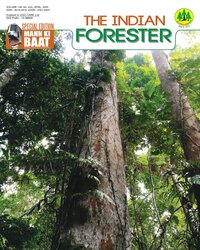Wastewater Reuse - A Prospective towards Efficient Reuse of Treated Wastewater from Sugar Industries of River Ganga Basin for Irrigation
DOI:
https://doi.org/10.36808/if/2023/v149i4(A)/169906Keywords:
Sugar Mills, Charter, Irrigation Management Protocol, Treated Wastewater, Freshwater Consumption.Abstract
The sugar industry consumes a higher volume of freshwater, generating around 1000 liters of wastewater per tonne of cane crushed. The wastewater generated from Sugar industry is complex with high Biochemical Oxygen Demand (BOD), Chemical Oxygen Demand (COD) and Total Suspended Solids (TSS). As per latest data of CPCB, 2021-22, total number of operational sugar Industry in Ganga River basin is 140, crushing around 739274.95 tonne of sugarcane per day, consuming 58461.16 KLD of freshwater and discharging 105061.51 KLD of effluent having 3.9 TPD of BOD load.
During 73rd episode of 'Mann Ki Baat' (MKB) (31/01/2021) Hon'ble Prime Minister of India emphasised on utilization of wastewater for irrigation purpose by farmers. To facilitate Sugar mills for adoption of best management practices and best available technologies, charter for water recycling and pollution prevention In sugar Industries has been formulated and implemented by Central Pollution Control Board (CPCB) with objective of reduction in freshwater consumption, wastewater discharge, pollution load and reuse of Treated Wastewater for irrigation purpose. This paper mainly focuses on groundwater conservation by reusing treated waste water from sugar mills for irrigation purpose. The successful Implementation of sugar charter reduced specific fresh water consumption by 53% and specific waste water discharge by 17% in 2021-22 compared to 2017-18. This resulted in saving of 2452.55 million liters of fresh water In spite of increase In total production in 2021-22 with respect to 2017-18.
References
Akhtar A., Singh M., Subbiah S. and Mohanty K. (2021). Sugarcane juice concentration using a novel aquaporin hollow fiber forward osmosis membrane. Food and Bioproducts Processing, 126:195-206.
Akhtar A., Subbiah S., Mohanty K. Sundar R. Unnikrishnan R. and Hareesh U.S. (2020). Sugarcane juice clarification by lanthanum phosphate nanofibril coated ceramic ultrafiltratlon membrane: PPO removal in absence of lime pre-treatment, fouling and cleaning studies. Separation and Purification Technology, 249:117157.
Kushwaha J.P. (2015). A review on sugar industry wastewater: sources, treatment technologies, and reuse. Desalination and Water Treatment, 53(2): 309-318.
Ranjan P., Singh S., MuteenA., Biswas M.K. and Vidyarthi A.K. (2021). Environmental reforms in sugar industries of India: An appraisal. Environmental Challenges, 4:100159.
Sahu O.P. (2018). Assessment of sugarcane industry: suitability for production, consump- tion, and utilization. Ann. Agrar Sci. 16:389-395. doi: 10.1016/j.aasci.2018.08.001.
Sheetal Kumar, R. (2019). Rethinking on growth mechanism of Indian sugar industry. J. Asia Bus. Stud., 13: 412-432. doi: 10.1108/JABS-12-2016-0182.
Solomon S.K. (2005). Environmental pollution and its management in sugar industry in India: an appraisal. Sugar fech., 7(1): 77-81.
Solomon S. (2016). Sugarcane production and development of sugar industry in India. Sugar Tech., 18: 588-602. doi: 10.1007/S12355-016-0494-2.
Sugar Charter: cpcb.nic.in/ngrba/charter.php
The Gazette of India (2016). MoEF&CC Notification on stipulated norms for treated effluent discharge for sugar sector, G.S.R. 35(E). Available online at https://parivesh.nic.in/writereaddata/ENV/envstandard/envstandard3.pdf, accessed on 18th April,2023.
Downloads
Downloads
Published
How to Cite
Issue
Section
License
Unless otherwise stated, copyright or similar rights in all materials presented on the site, including graphical images, are owned by Indian Forester.





